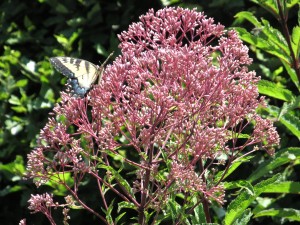Joe Pye weed (Eutrichum purpureum) is a native perennial commonly spotted onthe edge of farm fields in the eastern and northern U.S. (USDA hardiness zones 4 to 9). The wild species grows 5-7 feet high and 2-4 feet wide. It blooms from late July to September and is a magnet to attract bees and butterflies. Over the past two decades the “weed” has been tamed with the introduction of several shorter selections of Joe Pye. Here are the popular ones:
‘Gateway’ Joe Pye (E. purpureum ssp. maculatum) grows 5 ½ feet and offers month long show of mauve-pink domed flowers.
‘Chocolate’ Joe Pye (E. rugosa ‘Chocolate’) struts dark bronze/purple foliage and fuzzy white flowers.
‘Little Joe’ Joe Pye (E. dubium) is similar in appearance to Gateway. Plants grow 3-4 feet tall with whorls of green leaves and topped with dome-shaped heads of lavender pink flowers.
‘Baby Joe’ Joe Pye (E. dubium ‘Baby Joe’) grows only 2-3 feet tall and wide. It forms a bushy upright mound of coarse dark-green leaves, bearing large umbrella-like heads of magenta-lavender flowers in late summer.
‘Phantom’ Joe Pye (E. x ‘Phantom’) is a dwarf hybrid cultivar that grows to only 2-3 feet tall. It is a clump-forming herbaceous perennial that produces attractive and long-lasting, terminal, dome-shaped, deep pink-purple flowers atop attractive red stems, in September and October, make great cut flowers.
Hardy ageratum or mistflower (E. coelestinum) is old-fashioned 2-3 foot tall and wide perennial. It grows vigorously in old fields, meadows, and along stream banks in the South in late summer and early fall. Species is easy to grow and naturalizes freely.
Joe Pye grows just about anywhere, preferably in wet sites. Leaf edges may burn if soils become too dry. Clumps spread by underground rhizomes that are easily divided in early spring before new growth starts. Division, as well as thinning should be done frequently to ensure vigorous growth and reduce spread.Cuttings may also be rooted. Feed with slow release in early spring. Staking plants for support is generally unnecessary unless sited in too much shade. No serious insect or disease problems.
Joe Pye is utilized in perennial borders, rain gardens and mixed large containers


 Posted in
Posted in 
